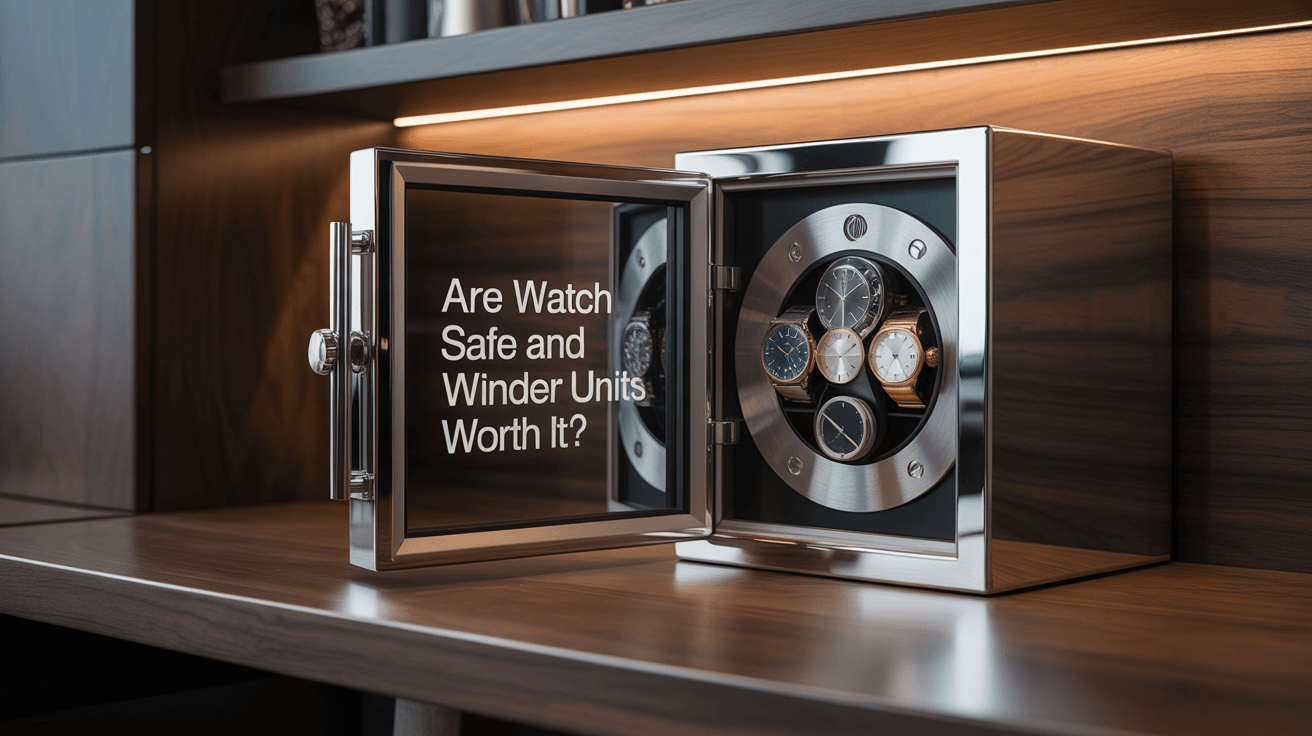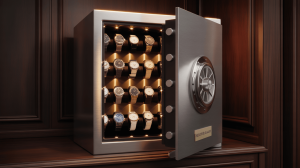Are Watch Safe and Winder Units Worth It? Pros and Cons Explained. Here’s the deal… balancing security, preservation, and convenience requires understanding what these combined units truly offer.
1. What Are Watch Safe and Winder Units?
A watch safe and winder unit merges a secure vault with automatic winding modules. It stores watches behind reinforced steel walls while keeping automatics running on precise turns-per-day (TPD) cycles. This integrated solution appeals to collectors who value both protection and timepiece readiness. But here’s the kicker… not every collector needs this level of sophistication, so let’s break down the benefits and drawbacks.
| Component | Function | Typical Feature |
|---|---|---|
| Vault | Safeguards against theft/fire | UL RSC/UL 72 Class 350 ratings |
| Winder Modules | Automatic winding | 650–2,000 TPD, CW/CCW options |
| Climate Control | Humidity & dust management | IP54 seals, desiccant packs |
2. Pro: Enhanced Security
Standard winders often sit on open desks—vulnerable to theft. Here’s the deal… combined units employ multi-bolt steel doors, reinforced hinges, and certified locks. Some models include biometric scanners and audit-trail logs. This high-security environment deters tampering and qualifies for insurance discounts, giving serious collectors peace of mind.
3. Pro: Preservation of Watch Movements
Automatic movements require regular motion to keep oils fluid. Without winding, lubricants congeal and accuracy drifts. A built-in winder cycles your watches precisely per manufacturer specs. But wait… this continuous motion reduces service intervals and prevents manual overwinding, extending each watch’s lifespan.
4. Pro: Ready-to-Wear Convenience
Imagine opening your safe to a fully wound, accurate watch—no resets needed. Here’s the deal… combined units eliminate daily winding chores, saving time and effort. They often feature programmable schedules, so each watch rotates only when necessary.
| Benefit | Traditional Storage | Winder Safe Unit |
|---|---|---|
| Timekeeping Accuracy | Manual winding required | Automated precision winding |
| Daily Convenience | Reset complications | Ready to wear at all times |
| Effort Saved | Frequent manual winding | Set-and-forget programming |
5. Pro: Display and Organization
Beyond function, many units showcase your collection behind tempered glass or acrylic panels with integrated LED lighting. Here’s the deal… these safes become décor pieces, organizing watches and jewelry in modular trays that can adapt as your collection grows.
6. Pro: Smart Features and Connectivity
Modern winder safes often integrate Bluetooth or Wi-Fi. But here’s the kicker… remote alerts—tamper, door-open, or low battery—arrive on your smartphone. Apps let you adjust winding schedules and review access logs, bringing enterprise-grade control to your home.
7. Con: High Upfront Cost
Quality combined units start around $1,000 and climb into the $5,000+ range. Here’s the deal… compared to standalone winders or basic safes, this is a significant investment. Budget constraints may lead you to separate solutions or simpler holders.
| Price Tier | Features Included | Typical Cost Range |
|---|---|---|
| Entry-Level | Basic winding + key lock | $1,000–$1,500 |
| Mid-Range | Climate control + keypad | $1,500–$3,000 |
| Premium | Biometric + smart app | $3,000+ |
8. Con: Maintenance Requirements
Combined units demand scheduled upkeep: battery or power checks, lock testing, motor calibration, and desiccant replacement. But wait… neglecting maintenance can lead to winding errors, lockouts, or humidity damage—so allocate time and resources accordingly.
9. Con: Noise and Energy Usage
While premium winders run under 25 dB, lower-end motors can hum or buzz. Here’s the deal… continuous winding uses electricity; battery backups and sleep modes mitigate this but won’t eliminate power draw entirely.
10. Con: Installation and Space
These safes are bulky and heavy, requiring floor or wall anchoring. But here’s the kicker… you need sufficient clearance for door swings and wiring. If space is at a premium, standalone winders or small safes may be more practical.
| Installation Aspect | Standalone Winder | Combined Safe Unit |
|---|---|---|
| Footprint | Compact | Large (console or floor) |
| Anchoring | None | Bolt-to-floor/wall required |
| Setup Complexity | Plug and play | Professional installation advised |
11. Weighing Pros vs. Cons
Combine the benefits—security, convenience, preservation—with the drawbacks—cost, maintenance, space. Here’s the deal… if your collection includes multiple automatics worth thousands, a combined unit may justify the price. For casual owners, separate components could suffice.
12. Ideal Scenarios for Combined Units
Collectors with:
● High-value automatics needing precise winding
● Desires for maximum security and climate control
● Interest in smart alerts and remote oversight
But here’s the kicker… if you travel frequently, portability may outweigh integrated features.
13. Alternatives to Combined Units
Consider:
● Basic watch winders plus standalone home safe
● Modular travel winder cases and desk safes
● Hydraulic or key-lock vault for security, separate winder
Here’s the deal… mixing and matching can cut costs and target features.
| Solution | Security Level | Winding Capability |
|---|---|---|
| Winder + Basic Safe | Medium | High when winder engaged |
| Travel Winder Case | Low | Moderate for travel-only use |
| Dedicated Home Safe | High | None (manual winding required) |
14. How to Choose What’s Right for You
Assess your:
● Collection value and complexity
● Budget and space constraints
● Desire for automation vs. manual control
● Maintenance willingness
But here’s the kicker… create a feature-priority checklist and score options side by side before deciding.
15. Final Recommendations
For serious collectors with multiple high-end automatics, combined watch safe and winder units offer unmatched protection and convenience. Casual enthusiasts may prefer standalone winders and affordable safes. Here’s the deal… choose a solution that aligns with your lifestyle, collection size, and security needs.
Conclusion
Watch safe and winder units deliver integrated security, precision winding, and smart features—but at a premium. But here’s the kicker… weigh the long-term benefits against cost and maintenance before you buy to ensure it’s truly worth it.
FAQ
Q1: Are combined units louder than standalone winders?
Premium models run under 25 dB; lower-end units may be slightly louder but generally remain unobtrusive.
Q2: How often perform maintenance?
Test locks and batteries quarterly; replace desiccants annually; run empty winder cycles monthly.
Q3: Can I override automatic winding?
Most units allow manual pause or removal of winder trays for static storage.
Q4: Do combined units save space?
They consolidate two functions into one footprint but require more space than a standalone winder.
Q5: Are smart alerts secure?
Use encrypted connections and strong unique passwords to protect remote monitoring functions.







